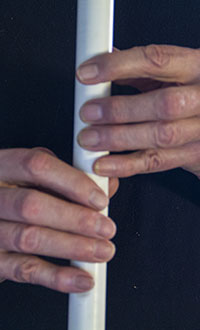LESSONS, FINGERING CHARTS, videos & reviews
A collection of resources to help you get started playing your new chromophone.

beginner's tips
The first thing you will want to do is to get the feel of your new instrument. Hold it, Feel its weight. Position your left hand on the upper five holes with your thumb on the thumb hole, and your right hand over the lower four. Chromophones with indented holes also have an indentation for the right thumb. Let your fingers find and feel the holes, covering them with the pads of your fingers as shown to the left (above on small devices). Blow softly into the mouthpiece. If you have completely covered the holes, you should hear the lowest, or root tone of the chromphone. If you blow a little harder, the tone will go up an octave. This is the second overtone. Blowing a little harder still will produce the third overtone which is a fifth higher still. The fourth overtone is 2 octaves above the root tone. There is one higher overtone that approximates a major third, but it is not normally used. It is good practice switching between the four overtones in order to get the feel of playing in the different registers. Here is an example of what theses four tones sound like on the G chromophone.
Before looking at the fingering chart, just go ahead and have some fun experimenting with your instrument. See what you can do with it. Can you play some simple tunes? Learning to play well is a combination of discipline and enjoyment. Learn a little bit at a time, and then take a break and see if you are able to apply what you learned as you are fooling around. Now take a look at the fingering chart for your chromophone. You can view or download a pdf of it using one of the links below.